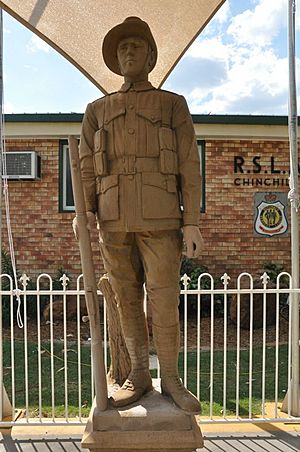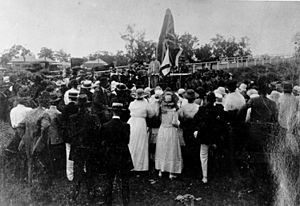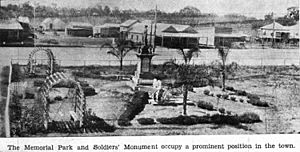Chinchilla Digger Statue facts for kids
Quick facts for kids Chinchilla Digger Statue |
|
|---|---|

Digger Statue, 2011
|
|
| Location | 57 Heeney Street, Chinchilla, Western Downs Region, Queensland, Australia |
| Design period | 1914 - 1919 (World War I) |
| Built | 1919 |
| Architect | Andrew Lang Petrie |
| Official name: Soldier Statue, Chinchilla, Chinchilla WWI Memorial, Chinchilla 'Digger' Statue | |
| Type | state heritage (built) |
| Designated | 1 August 1999 |
| Reference no. | 601269 |
| Significant period | 1919-1977, 1992 onwards |
| Significant components | memorial - soldier statue, plaque |
| Builders | A L Petrie & Son |
| Lua error in Module:Location_map at line 420: attempt to index field 'wikibase' (a nil value). | |
The Digger Statue is a special memorial located at 57 Heeney Street in Chinchilla, Australia. It was designed by Andrew Lang Petrie and built in 1919 by his company, A L Petrie & Son. This statue is also known as the Chinchilla WWI Memorial or the Chinchilla Soldier Statue. It was added to the Queensland Heritage Register on August 1, 1999, which means it's an important historical site.
Contents
History of the Chinchilla Digger Statue
The Chinchilla Digger Statue was created as part of the Chinchilla War Memorial. It was officially revealed on January 30, 1919. The Governor of Queensland, Sir Hamilton John Goold-Adams, was there for the unveiling.
The memorial was designed and built by a famous company called AL Petrie of Toowong, Brisbane. They made many war memorials across Queensland.
Why War Memorials Were Built
After World War I (1914-1918), many towns in Australia built war memorials. These memorials helped people remember the soldiers and nurses who served. They also honored those who lost their lives.
About 60,000 Australians died in the war. This was a huge number for a country with only about 4 million people. War memorials became sacred places. They were like substitute graves for soldiers buried far away.
The Statue's Original Location
The Chinchilla War Memorial first stood in a small park on Chinchilla Street. This was a very important spot in the town. In the 1920s, the Queensland Country Women's Association helped make the park beautiful.
Old photos from 1935 show a lovely garden. It had paths leading to the memorial, which was the main focus. There were also palm trees and a white picket fence.
Moving the Statue
By the 1970s, the center of Chinchilla town had moved. It shifted from Chinchilla Street to Heeney Street. Because of this, the war memorial was also moved in 1977.
The statue was separated from its original base. The base was rebuilt in Fuller Place in Heeney Street in 1979. It was topped with a spire, a tall pointed structure.
The soldier statue itself was kept in storage for a while. It had been damaged. In 1992, a group from the Returned and Services League of Australia (RSL) raised money. They wanted to fix the statue and move it to the RSL Hall.
So, the statue was restored and placed in front of the RSL Hall. This hall is also on Heeney Street, a short distance from Fuller Place.
What the Chinchilla Digger Statue Looks Like
The Chinchilla soldier statue is located in front of the Chinchilla RSL Hall. It faces the street.
Statue Details
The statue is made of sandstone and is a bit smaller than a real person, standing about 1.54 meters tall. It shows an Australian infantryman, or "digger." He wears a slouch hat, which is a type of hat worn by Australian soldiers.
The soldier stands in a relaxed pose, with the butt of his rifle resting on the ground. A tree stump supports the rifle at its base. This was a common design for soldier statues.
The statue stands on a sandstone block. This block is a part of the original base. It has carved flags on the front. These flags are the British Union Jack and the Australian flag. They show the strong connection Australia had to Britain at the time.
Below this block is a newer, larger sandstone block. It has a brass plaque that says: "Renovated & Relocated by the RSL Women's Auxiliary 1992." The whole statue stands on a concrete base. A modern metal fence surrounds it. There is also a shade structure built over it.
Changes to the Statue
Over time, the statue has been painted with colors to make it look more realistic. However, this was not how it looked originally. Also, the hands and rifle had to be replaced because of earlier damage.
The Chinchilla statue is one of 55 similar soldier statues still existing in Queensland. These statues were very popular types of war memorials built around World War I.
Why the Statue is Important
The Chinchilla Digger Statue is listed on the Queensland Heritage Register because it's important to Queensland's history.
It was built in 1919 to remember the local community's efforts in World War I. Even though it has moved, it still reminds people of Chinchilla's contribution to the war. Its new location at the RSL Hall connects it to the local RSL branch.
The statue has changed over time. It no longer has its original base or the names of soldiers. It has also been repaired and painted. But it is still a significant part of a group of soldier statues across Queensland. These statues are the most common type of war monument in the state.
Images for kids




